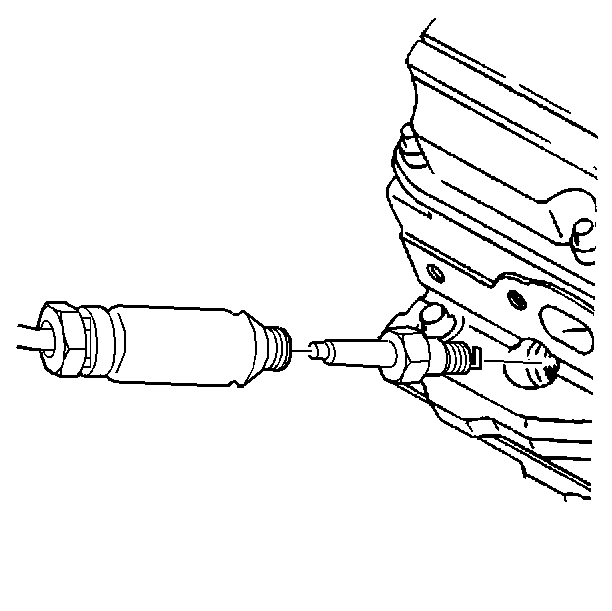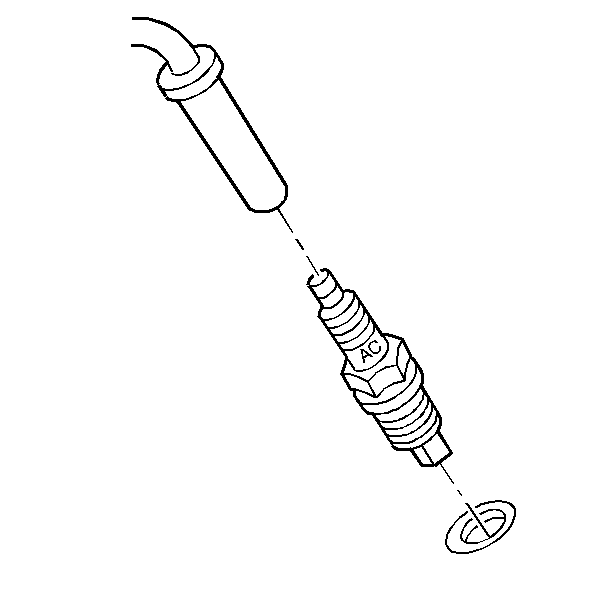Spark Plug Replacement 3800 L36 (VIN K)
Removal Procedure
Tools Required
J 38491 Spark Plug Heat Shield Remval Tool
- Turn OFF the ignition switch.
- Disconnect the spark plug wires from the spark plugs. Refer to Spark Plug Wire Harness Replacement .
- Clean the spark plug recess area.

Notice: Clean the spark plug recess area before removing the spark plug. Failure to do so could result in engine damage because of dirt or foreign material entering the cylinder head, or by the contamination of the cylinder head threads. The contaminated threads may prevent the proper seating of the new plug. Use a thread chaser to clean the threads of any contamination.
Remove the spark plugs from the engine.
Installation Procedure
- Measure the spark plug gap on the plugs to be installed. Compare the to gap measurement to the specification. Refer to Spark Plug Usage . Correct the gap as needed.
- Install the spark plugs to the engine.
- Connect the spark plug wires to the spark plugs in the proper position. Refer to Spark Plug Wire Harness Replacement .
Notice: Use only the spark plugs specified for use in the vehicle. Do not install spark plugs that are either hotter or colder than those specified for the vehicle. Installing spark plugs of another type can severely damage the engine.
Notice: It is important to check the gap of all new and reconditioned spark plugs before installation. Pre-set gaps may have changed during handling. Use a round wire feeler gauge to be sure of an accurate check, particularly on used plugs. Installing plugs with the wrong gap can cause poor engine performance and may even damage the engine.
Notice: Be sure plug threads smoothly into cylinder head and is fully seated. Use a thread chaser if necessary to clean threads in cylinder head. Cross-threading or failing to fully seat spark plug can cause overheating of plug, exhaust blow-by, or thread damage. Follow the recommended torque specifications carefully. Over or under-tightening can also cause severe damage to engine or spark plug.
Notice: Use the correct fastener in the correct location. Replacement fasteners must be the correct part number for that application. Fasteners requiring replacement or fasteners requiring the use of thread locking compound or sealant are identified in the service procedure. Do not use paints, lubricants, or corrosion inhibitors on fasteners or fastener joint surfaces unless specified. These coatings affect fastener torque and joint clamping force and may damage the fastener. Use the correct tightening sequence and specifications when installing fasteners in order to avoid damage to parts and systems.

Tighten
Tighten the spark plugs to 15 N·m (11 lb ft).
Spark Plug Replacement 3100 L82 (VIN M)
Removal Procedure
Tools Required
J 38491 Spark Plug Heat Shield Removal Tool
- Turn OFF the ignition switch.
- Remove the spark plug wires from the spark plugs. Refer to Spark Plug Wire Harness Replacement .
- Clean the spark plug recess area.

Notice: Clean the spark plug recess area before removing the spark plug. Failure to do so could result in engine damage because of dirt or foreign material entering the cylinder head, or by the contamination of the cylinder head threads. The contaminated threads may prevent the proper seating of the new plug. Use a thread chaser to clean the threads of any contamination.
Remove the spark plugs from the engine.
Installation Procedure
- Measure the spark plug gap on the spark plugs to be installed. Compare the measurement to the gap specifications. Refer to Spark Plug Usage . Correct as needed.
- Install the spark plugs to the engine.
- Connect the spark plug wires to the spark plugs. Refer to Spark Plug Wire Harness Replacement .
Notice: Use only the spark plugs specified for use in the vehicle. Do not install spark plugs that are either hotter or colder than those specified for the vehicle. Installing spark plugs of another type can severely damage the engine.
Notice: It is important to check the gap of all new and reconditioned spark plugs before installation. Pre-set gaps may have changed during handling. Use a round wire feeler gauge to be sure of an accurate check, particularly on used plugs. Installing plugs with the wrong gap can cause poor engine performance and may even damage the engine.
Notice: Be sure plug threads smoothly into cylinder head and is fully seated. Use a thread chaser if necessary to clean threads in cylinder head. Cross-threading or failing to fully seat spark plug can cause overheating of plug, exhaust blow-by, or thread damage. Follow the recommended torque specifications carefully. Over or under-tightening can also cause severe damage to engine or spark plug.

Notice: Use the correct fastener in the correct location. Replacement fasteners must be the correct part number for that application. Fasteners requiring replacement or fasteners requiring the use of thread locking compound or sealant are identified in the service procedure. Do not use paints, lubricants, or corrosion inhibitors on fasteners or fastener joint surfaces unless specified. These coatings affect fastener torque and joint clamping force and may damage the fastener. Use the correct tightening sequence and specifications when installing fasteners in order to avoid damage to parts and systems.
Tighten
Tighten the spark plug to 15 N·m (11 lb ft).
